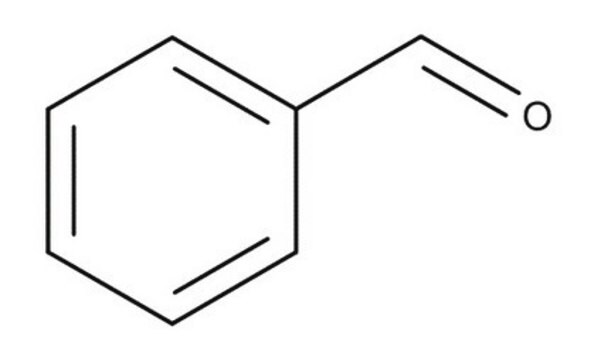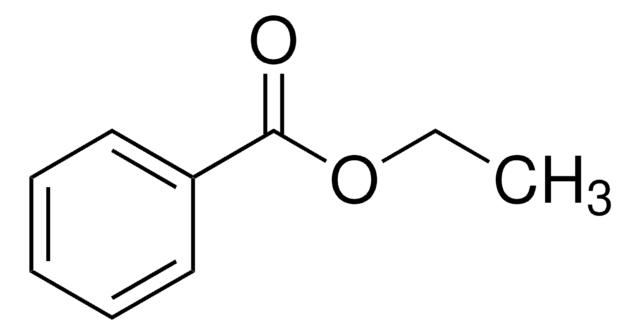Y0001064
Benzaldehyde
European Pharmacopoeia (EP) Reference Standard
Sinonimo/i:
Bitter almond
About This Item
Prodotti consigliati
Grado
pharmaceutical primary standard
Densità del vapore
3.7 (vs air)
Tensione di vapore
4 mmHg ( 45 °C)
Famiglia di API
benzaldehyde
Temp. autoaccensione
374 °F
Limite di esplosione
1.4 %, 20 °F
Produttore/marchio commerciale
EDQM
Indice di rifrazione
n20/D 1.545 (lit.)
P. eboll.
178-179 °C (lit.)
Punto di fusione
−26 °C (lit.)
Densità
1.044 g/cm3 at 20 °C (lit.)
applicazioni
pharmaceutical (small molecule)
Formato
neat
Temperatura di conservazione
2-8°C
Stringa SMILE
O=Cc1ccccc1
InChI
1S/C7H6O/c8-6-7-4-2-1-3-5-7/h1-6H
HUMNYLRZRPPJDN-UHFFFAOYSA-N
Cerchi prodotti simili? Visita Guida al confronto tra prodotti
Descrizione generale
Applicazioni
Confezionamento
Altre note
Prodotti correlati
Avvertenze
Danger
Indicazioni di pericolo
Classi di pericolo
Acute Tox. 4 Inhalation - Acute Tox. 4 Oral - Aquatic Chronic 2 - Eye Irrit. 2 - Repr. 1B - Skin Irrit. 2 - STOT SE 3
Organi bersaglio
Respiratory system
Codice della classe di stoccaggio
6.1C - Combustible acute toxic Cat.3 / toxic compounds or compounds which causing chronic effects
Classe di pericolosità dell'acqua (WGK)
WGK 1
Punto d’infiammabilità (°F)
145.4 °F - closed cup
Punto d’infiammabilità (°C)
63 °C - closed cup
Scegli una delle versioni più recenti:
Certificati d'analisi (COA)
Ci dispiace, ma al momento non ci sono COA disponibili online per questo prodotto.
Se ti serve aiuto, non esitare a contattarci Servizio Clienti
Possiedi già questo prodotto?
I documenti relativi ai prodotti acquistati recentemente sono disponibili nell’Archivio dei documenti.
I clienti hanno visto anche
Protocolli
-Tolualdehyde; Valeraldehyde; Isovaleraldehyde
Il team dei nostri ricercatori vanta grande esperienza in tutte le aree della ricerca quali Life Science, scienza dei materiali, sintesi chimica, cromatografia, discipline analitiche, ecc..
Contatta l'Assistenza Tecnica.










